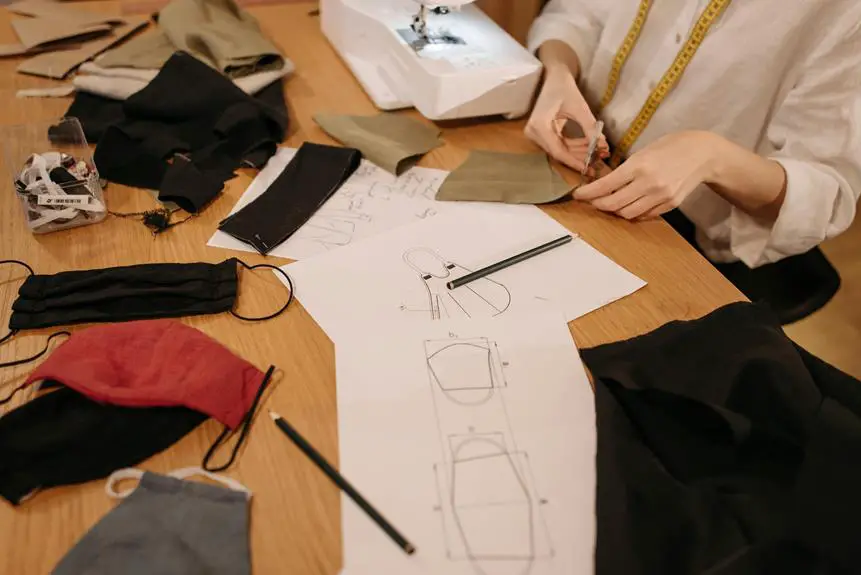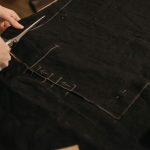When you think about sewing, it's easy to overlook the role of accurate cutting, but it's essential for achieving the results you want. If your cuts aren't precise, you may end up with garments that don't fit well or look unprofessional. By focusing on accurate techniques, you can not only improve the quality of your work but also reduce fabric waste. As you explore the tools and methods that can enhance your cutting skills, you'll discover how a little attention to detail can make a significant difference in your sewing projects. What's the first step you should take?
Table of Contents
Key Takeaways
- Accurate cutting ensures professional-looking garments by preventing fraying and inaccuracies, leading to cleaner edges.
- Precise cuts enhance garment fit, reducing issues like gaping or tight spots for a flattering silhouette.
- Careful cutting techniques minimize fabric waste, enabling better use of materials and cost efficiency.
- Using sharp tools and reliable measuring devices prevents common mistakes that can compromise garment quality.
Understanding Accurate Cutting
Accurate cutting is crucial for achieving professional-looking results in your sewing projects. When you cut fabric, you're creating the foundation of your garment. If you make mistakes here, it can lead to uneven seams and awkward fits.
To get it right, start by using sharp scissors or a rotary cutter. Dull tools can fray the edges and create inaccuracies.
Next, always measure twice before cutting once. Use a reliable measuring tape and a straight ruler to ensure your dimensions are precise. Lay your fabric flat on a cutting mat and pin your pattern pieces securely to prevent slipping. When you cut, follow the lines carefully, and allow your tools to guide you.
Don't forget about the grainline of the fabric, either; cutting against it can distort the shape of your piece. If you're working with patterned fabric, take your time to align the design correctly, ensuring a cohesive look.
Impact on Garment Fit
Mistakes made during cutting can significantly affect how a garment fits, leading to uncomfortable or unflattering results. When you cut fabric inaccurately, you may end up with pieces that don't align correctly, causing uneven seams and awkward drapes. This misalignment can create tight spots or gaping areas, making the garment unwearable.
If you're not careful with measurements, you might cut a pattern too small or too large. A too-small garment can restrict movement and cause discomfort, while a too-large piece can look baggy and unkempt. Both scenarios result in a garment that doesn't enhance your figure as intended.
Moreover, inaccurate cutting can also affect the garment's intended design. Elements like darts, pleats, and hems rely on precise cutting to function correctly. If these features are out of place, they won't create the desired silhouette, leaving you with a garment that's less than flattering.
In short, accurate cutting lays the foundation for a well-fitting garment. By taking the time to measure and cut carefully, you ensure that your finished piece not only looks good but also feels good when worn. Your confidence will shine through when you wear something that fits perfectly.
Waste Reduction Techniques
Implementing effective waste reduction techniques can help you maximize fabric usage and minimize leftover scraps during your sewing projects.
Start by planning your pattern layout carefully. Before cutting, arrange the pattern pieces on your fabric to see how they fit together. This way, you'll reduce the amount of fabric wasted by making the best use of every inch.
Consider using a fabric calculator. These tools can help you estimate how much fabric you'll need for your project, allowing you to buy only what's necessary.
Additionally, save all your scraps! Even small pieces can be used for patchwork, appliqué, or other creative projects.
Another effective technique is to repurpose old garments. Instead of tossing out worn clothes, you can cut them into usable pieces for new projects.
Tools for Precision Cutting
Having the right tools can make all the difference in achieving precise cuts when sewing. Investing in quality cutting tools not only enhances your accuracy but also elevates your overall sewing experience.
Here's a list of essential tools you should consider:
- Fabric Scissors: A good pair of sharp fabric scissors is crucial. They're designed to cut fabric smoothly without fraying the edges.
- Rotary Cutter: This tool is perfect for cutting multiple layers of fabric quickly and accurately. It's especially useful for straight lines and curves.
- Cutting Mat: A self-healing cutting mat protects your surfaces and keeps your blades sharp. It provides a grid for precise measurements, too.
- Ruler: A clear acrylic ruler helps you measure and cut straight lines with confidence. Look for one with both standard and metric measurements.
Common Cutting Mistakes
Cutting fabric can be tricky, and even seasoned sewists often overlook simple errors that can lead to uneven edges or wasted material.
One common mistake isn't using the right cutting tools. Dull scissors or rotary cutters can cause jagged edges, making it difficult to achieve clean lines.
Another issue arises from ignoring the fabric grain. Cutting against the grain can distort the fabric, resulting in pieces that don't fit together properly.
Additionally, not measuring correctly can lead to cutting pieces too small or too large, which disrupts the overall project.
You might also neglect to double-check your pattern alignment. Misalignment can cause mismatched seams and wasted time in re-cutting.
Failing to pin or secure fabric before cutting can lead to shifting, resulting in uneven pieces.
Tips for Perfect Cuts
To achieve perfect cuts, always start with sharp tools and a clean, flat workspace. These foundational elements are crucial for precision in your sewing projects.
Here are some tips to help you make flawless cuts:
- Choose the Right Tool: Use fabric scissors or a rotary cutter, as these are designed for clean cuts. Dull blades can lead to jagged edges and mistakes.
- Measure Twice, Cut Once: Always double-check your measurements before cutting. This simple practice prevents costly errors and wasted fabric.
- Pin or Weigh Down Your Fabric: Secure your fabric with pins or weights to prevent it from shifting while you cut. This ensures that your lines remain straight and accurate.
- Follow the Grain: Identify the fabric grain and cut along its lines. This will help maintain the fabric's structure and ensure your pieces fit together seamlessly.
Practicing Your Skills
To master accurate cutting, you need to practice essential techniques and familiarize yourself with the right tools.
Start by honing your precision cutting skills and exploring how accurate measurements can transform your sewing projects.
With consistent practice, you'll find that your cutting becomes more efficient and reliable.
Techniques for Precision Cutting
Mastering precision cutting requires consistent practice and attention to detail in your sewing projects. To enhance your skills, implement these techniques that will lead to better results:
- Use a Cutting Mat: A self-healing cutting mat provides a stable surface and helps maintain the sharpness of your blades.
- Align Your Fabric: Always lay your fabric flat and ensure the grainline is straight. This alignment prevents distortion and ensures uniformity in your cuts.
- Practice Steady Hand Movements: Take your time and move your cutting tool steadily. A rushing motion can lead to jagged edges and uneven cuts.
- Make Test Cuts: Before cutting into your main fabric, practice on scraps. This helps you gauge the pressure needed and refine your technique without risking your primary material.
Tools for Accurate Measurements
Achieving precise cuts in sewing relies heavily on using the right tools for accurate measurements, so investing in quality measuring instruments is key to enhancing your skills.
Start with a reliable measuring tape. A flexible, easy-to-read tape helps you take measurements around curves and seams with accuracy.
Next, consider a clear ruler or quilting ruler. The marked increments allow you to make precise cuts and keep your fabric aligned. If you're working with patterns, a pattern weight can replace pins, giving you a stable hold without distorting the fabric.
Don't overlook the importance of a good cutting mat. A self-healing mat protects your surfaces and provides a grid for better alignment. Pair it with a rotary cutter for smooth, clean cuts, especially when dealing with multiple layers.
Frequently Asked Questions
How Does Fabric Type Affect Cutting Accuracy?
Fabric type impacts cutting accuracy significantly. If you're working with slippery or stretchy materials, you'll find it harder to maintain straight lines. Stiffer fabrics, however, hold their shape better, making your cuts more precise and reliable.
Can I Use Regular Scissors for Precision Cutting?
You can use regular scissors for precision cutting, but they might not give you the best results. Investing in fabric scissors designed for accuracy can make a significant difference in your cutting quality.
What Are the Best Cutting Techniques for Curved Patterns?
To cut curved patterns effectively, use sharp fabric scissors or rotary cutters. Keep your hand steady, and always follow the curve's shape. It's helpful to rotate your fabric instead of moving the scissors too much.
How Can I Maintain My Cutting Tools for Better Accuracy?
To maintain your cutting tools for better accuracy, regularly sharpen blades, clean them after use, and store them properly. This ensures they remain effective and precise, enhancing your overall cutting experience and results.
Is There a Specific Cutting Order for Multi-Piece Patterns?
Yes, there's a recommended cutting order for multi-piece patterns. Start with the largest pieces first, then move to smaller ones. This helps prevent fabric shifting and ensures you achieve accurate cuts throughout your project.
- How Does Ring Spun Cotton Affect Garment Fit and Shape Retention? - August 13, 2024
- What Are the Challenges in Producing Ring Spun Cotton? - August 13, 2024
- Is Ring Spun Cotton Suitable for Plus-Size Clothing? - August 13, 2024





